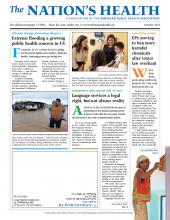
Ryan Orosco carries his son Johnny, 7, while his wife, Amanda, stands at their home following flooding in Brentwood, California, in January. As climate change intensifies storms, flooding is affecting more Americans in new areas of the country.
Photo by Jose Carlos Fajardo, courtesy MediaNews Group/East Bay Times/Getty Images
“One thing we know about climate change is that future storms are much more likely to be more intense, more severe and drop more rain than past storms.”
— Rob Moore
Flooding in U.S. communities is spilling well beyond floodplains and coastlines, displacing families, bankrupting towns and ending lives.
Flooding is the nation’s most common and costly natural disaster, displacing more than 3 million in 2022 alone — and climate change is making the problem worse.
As global warming strengthens hurricanes, tornadoes and other wet weather patterns, flooding has increased. California, Florida, Kentucky, New York, Texas and Vermont are among states that have experienced recent catastrophic flooding, sometimes in areas that had not flooded before.
“One thing we know about climate change is that future storms are much more likely to be more intense, more severe and drop more rain than past storms,” Rob Moore, MS, senior policy analyst at the National Resources Defense Council, told The Nation’s Health.

Ramiro Lopez, left, helps his daughter Veronica from a boat in Splendora, Texas, after being rescued during flooding caused by Tropical Depression Imelda in 2019.
Photo by Brett Comer, courtesy Houston Chronicle/Getty Images
The catastrophic flooding that took place in Vermont and New York this summer shows that no place is safe from flooding, said Melissa Roberts, founder and executive director of the American Flood Coalition. From July 10-11, a storm dropped as much as nine inches of rain in 48 hours in parts of Vermont, causing record damage and displacing 4,000 people.
“These flooding events that are hitting in places nowhere near (large water sources) are exactly what the future looks like,” Roberts told The Nation’s Health. “You can have this type of flooding anywhere, and as a country, we’re really not prepared for this.”
Just one inch of flood water can cause tens of thousands of dollars in damage. People of color and those who are low income are most likely to experience extreme flooding and not have the means to recover.
“Low-income people live in low-quality homes and low-lying areas,” said Shannon Van Zandt, PhD, MUP, professor of landscape architecture and urban development at Texas A&M University. “It’s kind of a combination of the physical vulnerability, the exposure and the social vulnerability all coming together.”
Hurricane Harvey struck the Gulf Coast of Louisiana and Texas in August 2017, killing more than 100 people. Van Zandt studied the local and federal response in Houston and the inequities that resulted. She found that people in wealthy neighborhoods recovered quickly through private insurance payouts and federal emergency compensation, and homeowners were able to afford temporary housing.
But the needs of low- and middle-income homeowners and renters who lived in the worst-affected areas were not met. A year after the hurricane, Black residents and those in Houston’s low-income neighborhoods were more likely to say their lives were still disrupted and less likely report they were to were able to get the help they needed a Kaiser Family Foundation survey found.
Flood prevention, preparation key
Flooding prevention begins with land-use planning and policies that ensure homebuyers and renters are aware of flood risks, experts say.
New York, Texas and several other states have adopted laws that require sellers to disclose past flood damage to homebuyers. Advocates have tried to get a national flood risk disclosure requirement, but so far Congress has not taken action.
In addition, many states have lax building regulations that allow construction on floodplains with no flood-resistant infrastructure, such as elevation standards. A study by the Federal Emergency Management Agency released in 2022 found that 39 states had inadequate building standards, among the worst being Louisiana, North Carolina and Pennsylvania. Top states were California, Florida, New Jersey and New York.
When determining where to build, FEMA flood maps have traditionally been the gold standard, used by engineers, planners and policymakers. But given climate change’s impact on weather patterns, most flood maps are now out of date, Moore said. Port Charlotte, Florida, which was heavily damaged by Hurricane Ian last year, used FEMA land use maps created in 2003. Updates to the maps can take years to complete.
Moore recommended that home buyers and renters supplement FEMA maps with up-to-date, reputable flood prediction models. The National Flood Insurance Program, for example, allows people to view data on insurance claims for flooding by year.
“There’s all kinds of different tools out there to help inform people about their flood risks,” Moore said.
Federal flood insurance reform is also needed to protect more U.S. residents and businesses, experts say.
Flood insurance is not standard in homeowner, renter or commercial insurance policies, and most mortgages do not require it. On average, only about 5% to 15% of U.S. homeowners carry flood insurance. Even in high-risk areas, flood insurance is rare.
Ninety percent of U.S. flood insurance policies are purchased through the National Flood Insurance Program, which is only slightly less expensive than private insurance. Annual NFIP premiums average $939, while private insurance averages $1,074, a 2023 analysis from FEMA and the National Association of Insurance Commissioners found.
“What we need is Congress to give FEMA the ability to discount flood insurance coverage based on a person’s income level, so that lower-income people can finally get a premium that they can afford to pay,” Moore told The Nation’s Health.
Adding to barriers, an increasing number of large insurers are pulling out of states and areas that are at high risk for natural disasters such as wildfires and floods. In June, Allstate and State Farm said they would withdraw or scale back property insurance in California, and in July, Farmers Insurance said it would discontinue some policies in Florida.

Workers construct a section of a Rapido home after Hurricane Dolly in Texas in 2015. Rapido helps communities quickly build housing for displaced people after flooding and other disasters.
Photo courtesy BCworkshop and Come Dream, Come Build
FEMA and other agencies offer some emergency funding for communities that experience flooding. But acquiring it can take months or years and requires navigating a complex federal system — with over 30 steps and an application of over 200 pages — that tends to favor civically active, high-income communities, Roberts said.
“You really can only (apply successfully) if you’re a wealthy community that can afford a consultant,” Roberts told The Nation’s Health. “We’re not going to see money go into communities with less resources because it’s so resource intensive to be able to apply.”
APHA and other public health organizations are working to build resilience in communities at high risk for damage from national disasters such as flooding. Having the ability to withstand and recover from adversity is important for both communities an individuals, who can suffer economic and mental health stressors. Building resilience requires managing risks, but also improving emergency response, especially for those who are most vulnerable.
Preparation for extreme flooding is key for states and communities, Roberts said. Leaders can prepare by planning and building flood-resistant infrastructure, moving homes from high-risk areas, increasing flood communication about floodplains and flood insurance, and creating a plan for affordable temporary housing. But few communities have a solid flooding plan in place, Roberts said.
“The most important thing is planning ahead of time,” Roberts said. “The worst time to be figuring this out is in the wake of a disaster.”
For more information, visit www.floodsmart.gov and www.apha.org/climate.
- Copyright The Nation’s Health, American Public Health Association









